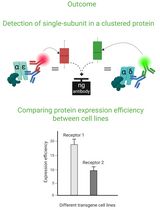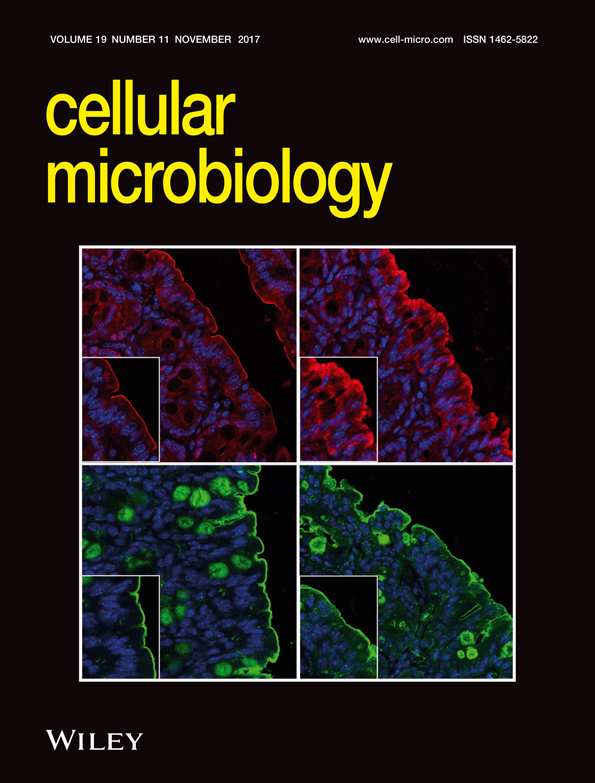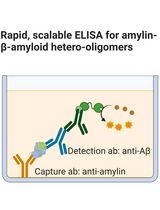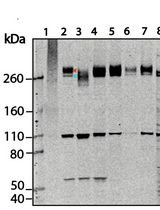- EN - English
- CN - 中文
Enhancement of Mucus Production in Eukaryotic Cells and Quantification of Adherent Mucus by ELISA
ELISA分析真核细胞中粘液生成增强并定量粘附的粘液
发布: 2018年06月20日第8卷第12期 DOI: 10.21769/BioProtoc.2879 浏览次数: 11696
评审: David CisnerosSongjie CaiEmiel P.C. van der Vorst

相关实验方案

Cluster FLISA——用于比较不同细胞系蛋白表达效率及蛋白亚基聚集状态的方法
Sabrina Brockmöller and Lara Maria Molitor
2025年11月05日 1122 阅读
Abstract
The mucosal surfaces of the gastrointestinal, respiratory, reproductive, and urinary tracts, and the surface of the eye harbor a resident microflora that lives in symbiosis with their host and forms a complex ecosystem. The protection of the vulnerable epithelium is primarily achieved by mucins that form a gel-like structure adherent to the apical cell surface. This mucus layer constitutes a physical and chemical barrier between the microbial flora and the underlying epithelium. Mucus is critical to the maintenance of a homeostatic relationship between the microbiota and its host. Subtle deviations from this dynamic interaction may result in major implications for health. The protocol in this article describes the procedures to grow low mucus-producing HT29 and high mucus-producing HT29-MTX-E12 cells, maintain cells and use them for mucus quantification by ELISA. Additionally, it is described how to assess the amount of secreted adherent mucus. This system can be used to study the protective effect of mucus, e.g., against bacterial toxins, to test the effect of different culture conditions on mucus production or to analyze diffusion of molecules through the mucus layer. Since the ELISA used in this protocol is available for different species and mucus proteins, also other cell types can be used.
Keywords: Mucus (粘液)Background
The interface of the body with the external environment is formed by mucosal surfaces. These mucosal epithelial tissues can be found for example in the gastrointestinal, respiratory, reproductive, and urinary tracts, and the surface of the eye. Due to their exposure to the external environment many microorganisms populate these tissues. Therefore, these epithelia have evolved multiple mechanisms of defense in response to their vulnerability to microbial attack. Many defensive compounds are secreted into the mucosal fluid, including mucins, antibodies, defensins, protegrins, collectins, cathelicidins, lysozyme, histatins, and nitric oxide (Kagnoff and Eckmann, 1997; Lu et al., 2002; Raj and Dentino, 2002).
To date, more than 20 genes encoding mucins have been identified in humans (Corfield, 2015). The human mucin (MUC) family comprises membrane-bound (MUC1, MUC3A/B, MUC4, MUC12, MUC13, MUC15 – 17, MUC20 and MUC21) and secreted mucins (MUC2, MUC5AC, MUC5B, MUC6 – 9, MUC19) (Moran et al., 2011; Tailford et al., 2015).
The mucus layer of the intestinal epithelial surface is mainly composed of the secreted mucin MUC2, but the membrane-bound mucins MUC1, MUC3 and MUC4 are also expressed (Kim and Ho, 2010). In addition, the intestinal mucus layer differs in terms of composition, organization and thickness along the gastrointestinal tract (Tailford et al., 2015). The secreted mucins form a gel-like structure adherent to the apical cell surface that constitutes a physical and chemical barrier between the luminal contents and the underlying epithelium (Allan, 2011). Inflammasome activity controls the secretion of mucus in goblet cells and increased secretion of mucus is observed as the microbiota becomes more diverse (Jakobsson et al., 2015). It is becoming apparent that mucus plays a crucial role in maintaining a homeostatic balance between microbiota and its host. Even small deviations from this dynamic interaction can have significant health effects, among which are colitis, colorectal cancer and susceptibility to infection (McGuckin et al., 2011; Hansson, 2012; Chen and Stappenbeck, 2014).
In this protocol, we describe the culture of in vitro models producing different amounts of mucus depending on their culture condition (static vs. semi-wet with mechanical stimulation (Navabi et al., 2013). These models are based on the little to no mucus-producing HT29 cell line, a human colon adenocarcinoma cell line, and its high mucus-producing derivative HT29-MTX-E12 (E12). Furthermore, it is described how to quantify the mucus produced in the different models by ELISA. In addition, the mucolytic compound N-acetyl-L-cysteine (NAC) is used to remove adherent mucus in order to quantify the amount of secreted adherent mucus. A schematic overview of the workflow described in this protocol is provided in Figure 1.
The method described in this protocol is suitable to study the protective effect of mucus against bacterial toxins (Reuter et al., 2018), to test the effect of different culture conditions on mucus production (Navabi et al., 2013) or to analyze diffusion of molecules through the mucus layer. Since the ELISA used in this protocol is available for different species and mucus proteins, other cell types can also be used.
Materials and Reagents
- 1.5 ml microcentrifuge tubes (SARSTEDT, catalog number: 72.690.001 )
- 15 ml centrifuge tubes (Corning, Falcon®, catalog number: 352196 )
- Absorbent paper
- 175 cm2 flask (Greiner Bio One International, CellStar®, catalog number: 660160 )
- Transwell® Inserts with 0.4 µm porous polyester membranes and 12 mm diameter (Corning, Transwell®, catalog number: 3460 )
- 12-well plate (included in Corning Transwell® package; if additional plates are required: Corning, Costar®, catalog number: 3513 )
- Cell lines HT29 (European Collection of Authenticated Cell Cultures (ECACC), catalog number: 91072201 ) and HT29-MTX-E12 (European Collection of Authenticated Cell Cultures (ECACC), catalog number: 12040401 ) or other cells to be tested for their mucus production
- Deionized water
- 70% ethanol
- Dulbecco’s modified Eagle’s medium (DMEM), high glucose, GlutaMAX (Thermo Fisher Scientific, GibcoTM, catalog number: 31966021 )
- Heat-inactivated fetal calf serum (FCS)
- 100x Penicillin/Streptomycin solution (Thermo Fisher Scientific, GibcoTM, catalog number: 15140122 )
- 100x Non-essential Amino Acids (Thermo Fisher Scientific, GibcoTM, catalog number: 11140050 )
- Phosphate buffered saline (PBS), pH 7.0-7.2 (Thermo Fisher Scientific, GibcoTM, catalog number: 14190144 )
- 0.05% Trypsin-EDTA solution (Thermo Fisher Scientific, GibcoTM, catalog number: 25300054 )
- ELISA kit for mucin (CLOUD-CLONE, catalog number: SEA705Hu )
Note: In this protocol, the ELISA kit SEA705Hu was used for measurement of human mucin 2 (MUC2). Kits for different species and mucus proteins are available at Cloud-Clone Corp., e.g., SEA413Mu for measurement of mouse mucin 1 (MUC1)). - N-acetyl-L-cysteine (Sigma-Aldrich, catalog number: A9165 )
- Cell culture medium (see Recipes)
- N-acetyl-L-cysteine working solution (see Recipes)
Equipment
- Sterile forceps
- Container for wash solution
- Multichannel Pipette (volume range: 20-200 µl)
- Water bath
- Humidified CO2 incubator (Thermo Fisher Scientific, model: HeracellTM 150i )
- Biological safety cabinet
- Hemacytometer (BRAND, Neubauer Improved, catalog number: 717805 )
- 37 °C incubator (e.g., CO2 incubator at 37 °C with CO2 switched off)
- Orbital shaker for use in CO2 incubators (Infors, model: Celltron )
- Ultrasonicator (Ultrasonic Homogenizer, BioLogics, model: 300VT )
- Microcentrifuge (Eppendorf, model: 5418 )
- Swing Bucket Centrifuge (Thermo Fisher Scientific, model: HeraeusTM MegafugeTM 16R )
- Microplate reader (Tecan Trading, model: Infinite® 200 )
Procedure
文章信息
版权信息
© 2018 The Authors; exclusive licensee Bio-protocol LLC.
如何引用
Reuter, C. and Oelschlaeger, T. A. (2018). Enhancement of Mucus Production in Eukaryotic Cells and Quantification of Adherent Mucus by ELISA. Bio-protocol 8(12): e2879. DOI: 10.21769/BioProtoc.2879.
分类
生物化学 > 蛋白质 > 免疫检测
细胞生物学 > 基于细胞的分析方法 > 蛋白质分泌
您对这篇实验方法有问题吗?
在此处发布您的问题,我们将邀请本文作者来回答。同时,我们会将您的问题发布到Bio-protocol Exchange,以便寻求社区成员的帮助。
Share
Bluesky
X
Copy link










